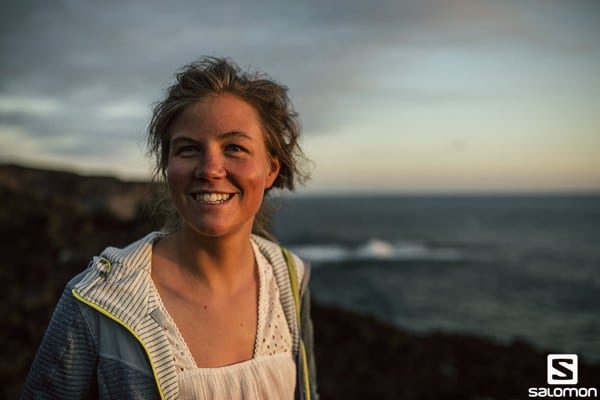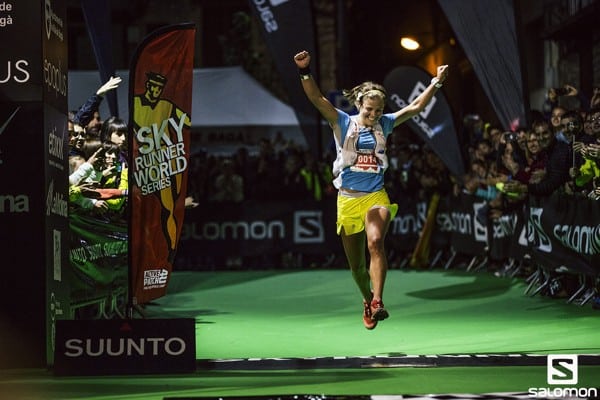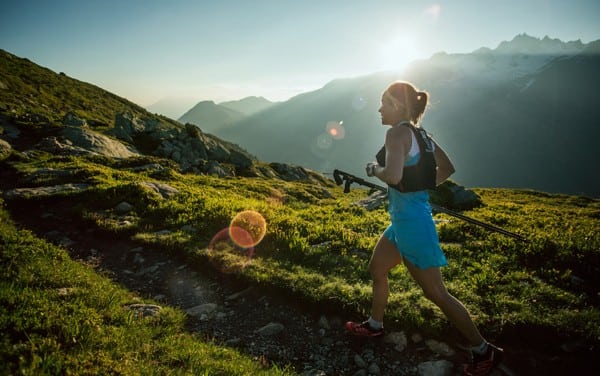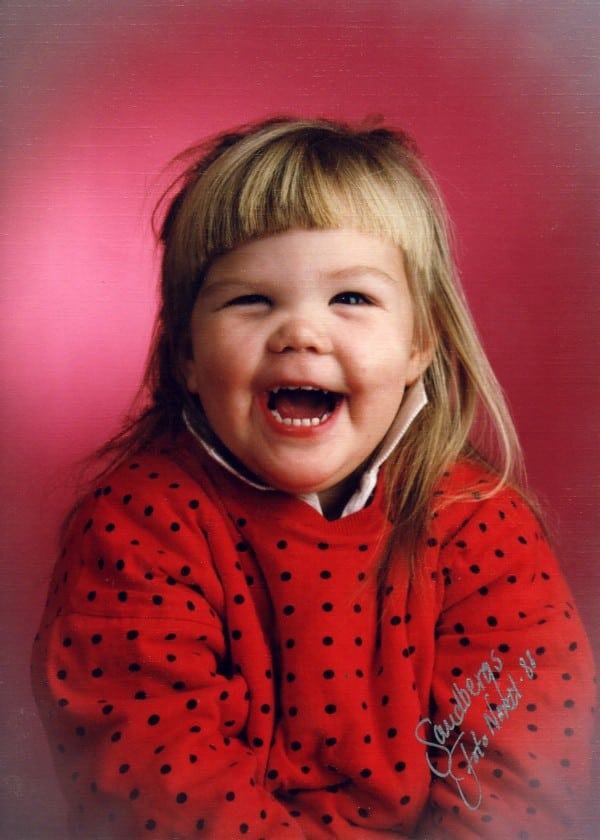Four years after she burst onto the trail running radar, Emelie Forsberg has become one of the sport’s biggest names. Incredible performances, an infectious love of nature, and a Kodak smile have made the young woman from Sweden’s Höga Kusten an athlete in demand. I caught up with her to find out what’s making her tick as 2015 draws to a close.

Emelie Forsberg. Photo: Jordi Saragossa
iRunFar: So, Emelie, you’ve spent most of the winter so far in France. There hasn’t been a huge amount of snow. Has that meant you’ve been running a little more than expected or have you been getting some alpine adventures in?
Emelie Forsberg: I have had some seriously good training weeks, and I’m so happy for that. As a two-season athlete, it’s sometimes hard to find the time to improve, but these weeks I felt that I have had some time for this. But for sure, mountain adventure is a part of my training.
I’ve had some nice days with Kilian [Jornet] climbing Chardonnet and playing around on Aiguilles du Midi glacier, Tacul, Dent Blanche, and some rock climbing, too. And yes I have been running much more! Though much more means two to three times a week. My teammate from the Swedish ski-mountaineering team has moved down and we are kind of neighbours so we have been training together. She’s a fast, flat runner so the runs we have done are flat and pretty fast!
iRunFar: Skimo will be on the agenda for winter. What’s planned? Also, what have you learned in your previous skimo seasons and how will you be approaching this year?
Forsberg: I will do the whole world cup which is a big calendar, almost every weekend from the 16th of January. I really love the skimo world cup because we compete against the same women all the time. So that creates a different ambience. In Skyrunning/trail running, we sometimes don’t meet the best ones, because they choose to do another race! I have been more focused on getting in some good training from mid-November/December than previous years. I stopped my running season earlier, took a break, and came back with a lot of energy!
iRunFar: Cool. So you call Chamonix your home base these days. When you lived in Tromsø, I remember you saying that you loved going back there and getting away from the craziness of racing in the Alps and Pyrenees. Does this mean that by living in Cham–the epicentre of European mountain sports–you have to sacrifice a little quiet time and peace or have you found a good life balance?
Forsberg: I have found a good balance, that is so important. For sure I struggled in the beginning, in one way, but I knew it was gonna’ be good. It has it positive sides, too. Like the weather is always amazing–for someone who is used to 30 sunny days a year. ;) And it’s very convenient to travel to all the races, I don’t need to fly that much and that is something I try to reduce. I can really appreciate this time down here as I know it’s only temporary. I want to live in a wild area! Soon!

A 14-year-old Emelie kayaking–she admits to being sports crazy. Photo courtesy of Emelie Forsberg.
iRunFar: Ah, so the remote wilderness is calling again. Tell us more. Where do you fancy going?
Forsberg: Norway is the perfect place! It has fascinating high-alpine mountains, fjords, wilderness, and also, it’s almost like Sweden!
iRunFar: Talking about living off the grid, can you tell me a little about your winter/early spring in Lyngen, how you decided to live there and what a ‘normal’-day’s activity was when you were there?
Forsberg: Yeah, we really enjoyed living there. You get to know the neighbours, and kind of the whole village, so you get to know people you normally wouldn’t get to know. You share only the same love for living there!
I always wake up early so normally I lit the fire to get some heat in the house–it was a small house so one fire in the morning was enough! Then the day turned normal, so to say, two to four hours training in the morning when there was some twilight and one hour training in the afternoon in the dark. The difference was that you are out in the wild mountains alone, so you think different and also make less meters. More difficult terrain, if you don’t climb a dry colouir which makes the meters go fast!
When March/April came, the sun shone for almost 24 hours so then it was harder to go inside, for sure the trainings became longer!
iRunFar: Great. Here we are at the end of 2015, which has been your fourth season since breaking through in 2012. Can you tell me what’s changed–and what hasn’t changed–in you, as a person and athlete, physically and mentally, since then?
Forsberg: Wow it’s crazy that times fly so fast. In one way, I’m totally the same. In another way, the way as an athlete, I changed a lot. But I think the main thing that has changed is my knowledge about training and the knowledge I have gotten from these years. I have been learning so much about training so I know what works and what doesn’t work. I have started to take pride in being a strong athlete, because 2012 I didn’t think at all that I was strong. I just did what I loved and I happened to be good at it. For me now it’s important to know that I can improve, have the motivation for it, and make a plan of how to get my athletic goal fulfilled. Now I also know how hard it is to be a professional athlete, you need to be motivated and never give up!
And this is what has changed. Until 2014, I would say I just did things I felt like doing. And that is often good, but I skipped those sessions that were harder for me, and that often means the things you need to improve. So I would say I have more of a plan now. I always have a goal with what I’m doing. But I managed to keep my happiness with it! That makes me proud! Still I think it’s not the whole world to win a race. It’s just a big thing.

Emelie winning the 2015 Ultra Pirineu. Photo: Jordi Saragossa
iRunFar: You mention staying happy and keeping it fun, Emelie. You always give the impression that means so much more to you than, say, winning a race or competing. What would you do if suddenly racing or training became a chore or made you unhappy? Would you walk away from it all?
Forsberg: Racing has only been a part of my life since four years, but nature and my passion for being outside– running/skiing/climbing/picking berries/walking/having a picnic/ gardening/farming–has always been there and I would not let anything take away my passion for that. That’s who I am… That is who I define myself as. I don’t define myself as a racer or competitor. But yes, I love winning, of course, it’s big, but at the same time it doesn’t matter at all.
iRunFar: Last year Kilian and yourself organised the Tromsø Skyrace, an event that was added to the Skyrunning calendar this year and that will be part of the inaugural ‘extreme’ series in 2016. Can you tell me about how that race came about, how it’s evolved, and whether it becoming a ‘big’ race worries you that it may lose its soul or become too big?
Forsberg: When we lived in Lyngen/Tromsø, we always talked about different training routes and eventually like– “Imagine a race here and here and there!?” For sure there are many possibilities and we wanted to choose a route where the start was close to civilisation, but still captured the wild mountains and technical terrain that we loved to train in. So we just did it! We set a date and started to work for it after that.
Yeah, the first year was a try-edition, we learned so much, and when we got accepted to join the SWS [Skyrunning World Series] in 2014 we needed to step it up. We did but we still have some things to do better, or many things actually!
It can’t be too big as it’s technically demanding and that makes it special. We are happy to keep it quite small but still the short race we can grow a little. But not too much! It creates a family atmosphere keeping it smaller. We love that! And I can’t bake 2,000 cinnamon buns!

Emelie and her sister, Tess, playing around. Photo courtesy of Emelie Forsberg.
iRunFar: Baking, of course, good you brought it up. Tell me a little about your baking career, when it started, where you worked, and if you’d like to maybe write a book about baking?
Forsberg: Ha ha, I would love to write a book about some of my favourite recipes. I have been working as a baker on Storulvån fjällstation, and I really loved it. I started out as a waitress there but I convinced the boss that they should send me to a baking course and so they did… I made all the bread and sweets. But for writing a book I feel like I need much more experience… I guess that is who I am, I don’t like to do things I don’t feel like I can do good.
iRunFar: Staying on the subject–can you explain for the non-Swedish readers what these three Swedish classics are, Lussekatter, Semlor, and Kanelbullar?
Forsberg: Mmmm! I’m actually eating a lussekatt right now! Always as a evening snack in December! It’s just saffron bun shaped as a ‘S.’ I make mine with some almond cream inside which is totally fantastic.
Semla: The Swedish eat it every Tuesday in February. A bun filled with cream and almond paste. Such a calorie bomb and it’s perfect after a big training. Or before. Or anytime actually.
Kanelbullar: Everyone must know what that is by this time, no? ! ;) [It’s a cinnamon bun!]

Emelie’s kanelbullar. Photo courtesy of Emelie Forsberg.
iRunFar: As well as being a successful athlete, you’ve also become someone that a lot of other trail runners and adventure lovers look up to and respect. You’ve a huge following. How does that make you feel, Emelie? Is there pressure or is it always a positive role to play?
Forsberg: It’s not something I think about very often at all. But sometimes it flickers through my mind for example when I get a question like now. Then I can get all like, Can I post this? What does that make people think about me? But then I realise that I’m nothing at all, you know? And I should just keep doing what I believe is right and what is true to me. For sure it makes me think an extra time, but that makes me a better person, too, so in one way I have a lot to be thankful for! So, yes, it’s always positive. Or maybe not when I talk about my passion for nature and that I try to do my best to live to give as little footprint as possible. To some people online I have no right to express any of that as I do travel approximately two times over the Atlantic sea, maybe five times to Sweden/Norway. This is a tricky subject for me as a ‘known’ person. But again, it makes me wanna’ change things, which in the end maybe just makes me better. And life shouldn’t just be perfect, ay?
iRunFar: I’d like to ask you about doping because it’s something you’ve talked about on your blog before. You’re known to be relaxed and open-mined but it was one of the only times that I experienced a zero-tolerance vibe from you when you entertained the case for lifetime bans for dopers in the sport. Doping has been a hot topic lately, especially in the U.S. What’s your opinion on it, Emelie?
Forsberg: It’s such a hard topic, and I sometimes don’t feel comfortable talking about it, actually. And I don’t want to blame particular people, but I do think that it should be a non-tolerance doping policy. As it is now, I respect the rules and don’t think about who I’m standing with on a start line. If someone has got caught for doping but are there, that’s how it is with the rules and I don’t think more about it.
But as it is now, the system can’t handle it, because the slightest doubt if the test is positive or not, it can ruin a person’s career if it’s not 100%. And of course it depends on which substance you get caught for. I mean EPO–sure, life ban. And talking with different people, one point of view that came up is that if really young people get caught–like if they are in a club where it’s “normal” to dope–then maybe yes up until 20 [years old], it maybe should be okay with a second chance.
But as I said, I don’t feel very good talking about this, even though I wish I didn’t feel this. I think it’s important to hear and see and read about this as it is something that does not belong in the sports world. Or anywhere else…
iRunFar: One aspect of the doping argument in trail and ultrarunning that tends to come up is that there’s no money in our sport so therefore it’s not worth it. However, the chance to live a lifestyle of travel, running, and adventures through sponsorship–pretty much like you have–is undoubtedly very attractive, don’t you think? Do you think that the industry as a whole has a responsibility to make sure its runners are clean?
Forsberg: That is an interesting thought. Because not many trail runners get tested, as the federations are not in WADA. I only get regularly tested because I’m a high-level ski-mountaineering athlete in the Swedish national team and therefore under WADA.
It would be fantastic if the main sponsor of trail runners could include this in the contract, let’s say six times a year at various times and location, not necessarily at a race. That would be a great step. I think a urine test is around 400 Euros, so not too bad.
iRunFar: Okay. When you first arrived on the scene, you only ran short races but since then you’ve obviously raced and won numerous ultras and also experienced your first 100 miler. In 2016, you’re planning to run shorter and faster races again. Why is that? What’s the thinking behind it?
Forsberg: I’m so excited for my year ahead! I remember 2012 when I ran my first ultras, I loved it but I wasn’t the strongest or even close. After that, I became stronger and stronger on ultras up to 110 kilometers and it felt actually easy in very many races. For sure I wanted to become stronger, and cut the percent time to the men, so I did but after a while I needed something more. You know? Don’t take me wrong, it’s never very easy to win an ultra but I started to feel to comfortable. I love winning, it’s so cool, but there should be something more to it. I don’t want to have it easy even though I will regret saying this when I start my summer training… hee hee. Flatter and faster it will become! And this is fun, too! I’m ready to struggle and to not be close to podiums, but it will give me something more.
iRunFar: So, tell me more about it, what specific races are you planning? Lidingöloppet (a huge 30k trail race in Stockholm, Sweden, where over 20,000 people run) is on the cards, right? Any chance of you deciding to do the whole ‘Swedish Classic?’ (It’s a Swedish institution to complete the four ‘classic’ events in a calendar year: the trail race called Lidingöloppet, the 90k cross-country ski race called Vasaloppet, a 300k bike race around a lake called Vätternrundan, and a 3k river swim called Vansbrosimningen.)
Forsberg: Ha ha! Not a chance I’m doing the classic . I’m not a big fan of either cycling or swimming. But one day if I change my mind to those sports it would be great fun. Yes Lidingöloppet is a goal. But it’s so big, I almost don’t want to talk about it because I know that the Swedes will think I can do well, and I really doubt I can! Ha ha!
iRunFar: There have been a whole crew of young, strong women coming through and crushing the shorter Skyrunning races. Who have you most been impressed with, who do you most like competing against, and do these young guns drive you to be better?
Forsberg: Yes, it is so awesome! It makes my heart warm thinking about all the young guns, especially the young girls. I’m impressed by them all, they all have their different stories which makes them special! Lucy Bartholomew, so cool that she can handle the ultras and she’s so young. Giulia Compagnoni, super strong VK runner and also one of the strongest juniors in the skimo world cup. And Yngvild Kaspersen, such a good year she had doing some really good times on road and also in the Sky distance and so many more! Yes for sure it inspires me to become better, as well as the ones in my own age, and also the ones that are older. It’s great to have so much inspiration all around you!

Emelie running near her Chamonix, France, home. Photo: Jordi Saragossa
iRunFar: In Fast and Light, the Salomon movie that was released a couple of months ago, we saw a side of you that’s not seen very often at all–the famous smile was replaced with tears and anguish when you lost your way at Trofeo Kima and missed out on the win and, most probably, the course record, too. What do you think of the movie, Emelie, and have you plans to go back and try again at Kima in 2016?
Forsberg: Oh gosh, I’m a bit ashamed. But it is true so I’m also happy to show that side of me. I want to give my best and when I lost my way I was so angry and disappointed. That is part of racing and for sure I know it’s not the world, but we are allowed to feel this every now and then because that’s human. In the end we know it means nothing compared to so many other things.
Man I want that record!
iRunFar: You’ve recently had a yoga workshop in Sweden and have been putting out some short videos of you practising some poses. What’s the relationship between yoga and running/mountaineering/skimo for you, Emelie?
Forsberg: This summer it has meant a lot. I did it quite often and I also entered a yoga course. It makes me relax my mind and also get to feel my body, see where there are tensions, and to see where my mind is going. For me it’s so good. I also feel much better in my body. Like I’m never gonna’ be super flexible, but I feel more balanced and soft.
iRunFar: You mentioned once that yourself and Kilian went for a beach-relaxing holiday after Diagonal des Fous a couple of years ago but only lasted a couple of days before the boredom kicked in and the mountains called! Have you two become better at taking it easy?
Forsberg: Ha ha! We now know that seven days on a beach is not possible, but this year I, for example, went to a yoga camp and after that I had some media weeks and Kilian also did some media weeks and that works better for us.
iRunFar: I know you like to be in the ‘now,’ Emelie, but have you thought about where and what you would like to be doing in say five years’ time? You can go crazy with the answer and dream if you like!
Forsberg: I’m a big dreamer! For sure I like to be right here and now but I always dream. And that is often about a small farm, some land, some forest, a big garden. And a dog! Kids in the future, too!

Emelie smiling big in 1988.
